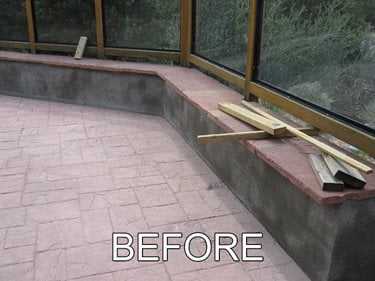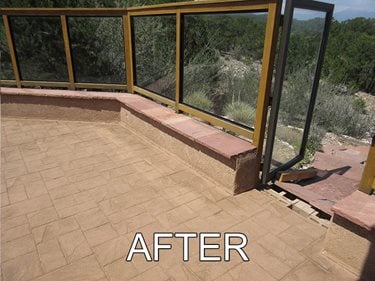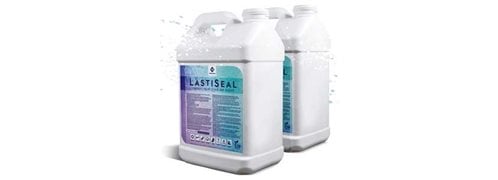- Concrete Sealer
- Comparison Chart of Concrete Sealers
- Buying Tips for Concrete Sealer Products
- Concrete Sealer Reviews: Sealer products other contractors use and recommend
- Common Questions about Concrete Sealers
- How to Remove Concrete Sealer
- Types of Sealers
- Acrylic Sealers
- Epoxy Sealers
- Penetrating Sealers
- Polyurethane Sealers
- Polyaspartic Sealers
- Application Surface
- Driveway Sealer
- Patio Sealer
- Pool Deck Sealer
- Sealers for Stamped Concrete
- Concrete Floor Sealers
- Concrete Countertop Sealers
- Pool Deck Sealer
- Exposed Aggregate Sealer
Tinted Sealers for Concrete
If you want to add just a hint of color to plain concrete or enhance an existing color, tinted concrete sealer is a great option.All decorative colored concrete should be sealed to protect the finish and preserve the color. But wouldn’t it be nice if you could both color and seal concrete in one step? That’s the beauty of tinted concrete sealers. They provide all the protective benefits of a clear concrete sealer along with a subtle dose of color. Not only do they save time and labor, they also save money by eliminating the expense of an integral color or concrete stain. Read on to learn more about the benefits and applications of tinted sealers and how to get the best results when using them.


Colored Concrete Sealer X-3 was used on this patio to remove the unwanted pink color. Stone Technologies, Corp.
What types of sealers can be tinted?
Both solvent- and water-based sealers can be tinted, depending on what you are trying to achieve. Some manufacturers offer pretinted sealers, while others provide tint concentrates in a wide array of colors that you can mix into a clear sealer at the jobsite. Pretinted sealers are convenient if you want predictable, consistent color. However, the color selection is limited and you don’t have the flexibility to match an existing color.
Tip: If you are tinting the sealer yourself, it’s important to use a pigment that is compatible with the sealer you are using. For example, if the sealer is a solvent-based acrylic, only use a solvent-based acrylic tint system, preferably from the same manufacturer.
Find contractors offering concrete sealing near me.
What are the best applications for a tinted sealer?
Tinted sealers can be used as a stand-alone, low-cost decorative finish or as a way to slightly alter or enhance an existing color. They also are a great solution for hiding color variations or touching up problem areas, such as transition zones between newer and older concrete.
RELATED: How to Fix Discolored Concrete
Like clear concrete sealers, you can apply most tinted sealers to interior or exterior surfaces including concrete floors, garages, driveways, sidewalks, walkways, pool decks, and patios. You can even apply tinted sealer over previously sealed concrete as long as you use a product compatible with the existing sealer base.
Tip: For stamped concrete applications, don’t use tinted sealer as a substitute for powdered color hardener or a tinted release agent. Color hardener is designed to strengthen the slab surface and make it denser, while a tinted release agent prevents the stamping tools from sticking to the concrete.
 Tintable Cure & Seal
Tint with color packs
Tintable Cure & Seal
Tint with color packs
 Colored Concrete Sealer X-4
High gloss finish available in 20 colors
Colored Concrete Sealer X-4
High gloss finish available in 20 colors
 Tinta' Seal
Color tint pack additive for solvent-based sealers
Tinta' Seal
Color tint pack additive for solvent-based sealers
 Acrylic Color Tint
Tint system for adding to clear solvent based acrylic sealers
Acrylic Color Tint
Tint system for adding to clear solvent based acrylic sealers
 Concrete Stain + Sealer in One
Waterproof, strengthen, preserve and beautify in one step
Concrete Stain + Sealer in One
Waterproof, strengthen, preserve and beautify in one step
How do tinted sealers compare with concrete stains and paints?
Although tinted sealers tend to produce more opaque color effects than penetrating stains, the color is more subtle and semi-translucent than a concrete paint. Water-based tinted sealers, which don't have the body to hold much color, tend to be more translucent than solvent-based tinted sealers. Like paints, however, many tinted sealers offer a wide array of color options. Some tinted water-based concrete sealers are available in more than 200 standard colors or can be custom matched to an existing color.
How do you apply tinted sealers?
Tinted sealers are applied with a sprayer or roller using the same application methods as those recommended for clear concrete sealers. Regardless of the method you use, always apply the sealer in thin, even coats vs. one thick coat, following the manufacturer’s recommendations. When sealer is applied too thickly, it may dry unevenly and result in unsightly blisters and bubbles.
Tip: When using a water-based tinted sealer, avoid spraying because the pressure and spray tip can cause the pigment to separate from the sealer.
How do you determine the right amount of tint to add?
Adding tint to a sealer is as easy as adding food coloring to a cake mix. Manufacturers typically offer the pigments in premeasured packs designed to be stirred into a gallon or 5 gallons of sealer. Use less pigment to achieve greater color translucency, similar to a concrete stain, and the maximum amount of pigment for the most opaque color effects. Just make sure you are using a tinting agent that is compatible with your sealer, and test the application in a small, inconspicuous area to ensure you will get the desired color and degree of translucency.
Tip: When tinting sealer yourself, do not add more than the recommended amount of pigment. Excess tint can cause over-pigmenting, which can result in streaking.
How long do tinted sealers last?
Just like a clear concrete sealer, tinted sealer will wear off a concrete surface over time and will require regular reapplication to preserve the color. For high-traffic exterior surfaces such as driveways and sidewalks, wear patterns will become evident sooner and will require more frequent sealer reapplication to maintain even color. If you want to avoid routine maintenance, you may be better off using integral coloring or a penetrating concrete stain.
For interior floors, traffic levels are also a consideration. In areas with heavy foot traffic, a tinted sealer may not be the best choice.
Tip: For outdoor surfaces, apply a topcoat of clear sealer over the tinted sealer to help protect the finish and extended the time required between reapplication. Indoors, applying a coat of floor wax over a tinted sealer will offer the same benefits.
Related:
Choosing the Best Applicator for Concrete Sealer
Advice on Choosing and Applying Sealers




